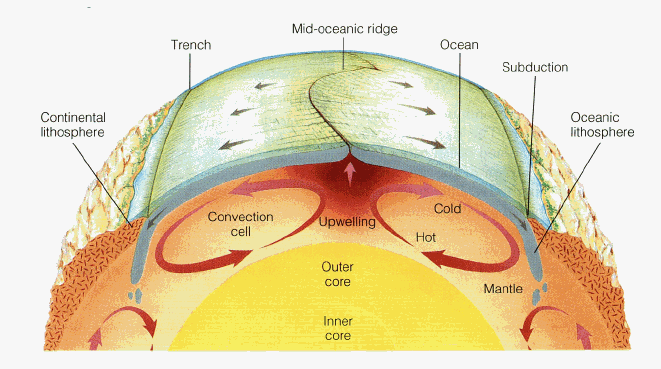Describe the Convection Currents That Occur Inside Earth
Tremendous heat and pressure within the earth cause the hot magma to flow in convection currents. The crust moves because of movements deep inside the earth.
Convection Currents 8th Grade Science
The convection currents are linked with natural convection in which the fluid motion occurs naturally such as buoyancy Optimism.
. Heat rising and falling inside the mantle. If a material is able to move even if it moves very slowly convection currents can form. Convection currents are the movement of fluid as a result of differential heating or convection.
The exception is that combustion in a zero-gravity. Shady or moist areas are cooler or able to absorb heat adding to the effect. Describe the convection currents that occur inside Earth.
The heating causes the liquid to rise toward the surface and break up the continental and oceanic crust into over 12 rigid plates. Fluids include liquids and gases. An example of convection current is shown in Fig.
These currents cause the movement of the tectonic plates that make up the earths crust. The convection currents as they carry heat upward with the magma. During convection heated particles of a fluid begin to flow transferring heat energy from one part of the fluid to another.
Describe differences in characteristics between the Outer Core and Inner Core. Convection in the mantle is the same as convection in a pot of water on a stove. Beneath Earths crust the convection cycle is whats happening in the mantle.
For example there are divergent convergent and transform plates. Heat transfer by convection is caused by differences in temperature and density within a fluid. Because the plastic-like asthenosphere acts as a liquid it makes the convection cycle possible.
Based on mantle convection each plate tectonic moves in a specific way. Explain the process of convection. In the case of the Earth convection currents refer to the motion of molten rock in the mantle as radioactive decay heats up magma causing it to rise and driving the global-scale flow of magma.
The mantle within the earths surface flows due to convection currents. The geosphere plate tectonics the atmosphere - wind the hydrosphere - ocean currents. Iron rich magma in the earths core heats up because of radiation and the pressure exerted by the other layers of the earth.
The asthenosphere is a layer of the upper mantle that can flow very slowly. Geologists have hypothesized that the movement of tectonic plates is related to convection currents in the earths mantle. The Earth is made out of a number of different layers and though we live on the.
Convection Currents and the Mantle. Describe how convection currents occur in. Convection currents are the result of differential heating.
Generated by radioactive decay in the core. These currents are mainly caused by a very hot material present in the deepest part of the mantle which rises upwards then cools sinks again and again repeating the same process of heating and rising. Convection currents within Earths mantle form as material near the core heats up.
As the core heats the bottom layer of mantle material particles move more rapidly decreasing its density. Hence Convection Current is defined as a process of continuous heating up of liquids. Convection currents occur in the magma of the Earth.
Convection currents describe the rising spread and sinking of gas liquid or molten material caused by the application of heat. These currents cause the movement of the tectonic plates that make up the earths crust. The convection currents also help transfer heat from Earths core where magma is created through radioactive decay to the mantle.
The transfer of heat by the movement of a heated fluid is called convection. The movement of the currents plays a factor in the movement of the mantle. Lighter less dense warm material rises while heavier more dense cool material sinks.
Convection currents are part of what drives global circulation of the Earths atmosphere. This heat in the crust trigger convection currents in the mantle. Sunlight or reflected light radiates heat setting up a temperature difference that causes the air to move.
Combustion generates convection currents. Convection currents describe the rising spread and sinking of gas liquid or molten material caused by the application of heat. Convection currents occur within.
The magma closest to the core will be hotter and therefore less dense than other layers. This heat transfer continues through the layers of the crust until it reaches the surface. Radioactive decay in the core of the Earth produces enough heat to melt the rocks that form magma.
Inside a beaker hot water rises. Convection currents describe the rising spread and sinking of gas liquid or molten material caused by the application of heat. How is heat transferred by conduction.
These currents drive plate tectonics. Tremendous heat and pressure within the earth cause the hot magma to flow in convection currents. It is this movement that creates circulation patterns known as convection currents in the atmosphere in water and in the mantle of Earth.
The convection current cannot take place in solids as the particles within the solids cannot flow easily and most of the free movement is mainly because of the difference in the density that is caused due to a huge transfer of heat between the plates. In the case of the Earth convection currents refer to the motion of molten rock in the mantle as radioactive decay heats up magma causing it to rise and driving the global scale flow of magma. Earths hot core and mantle provide a source of heat that drives convection currents in the asthenosphere.
What Is The Reason For Convection Currents In The Mantle Quora

What Will Happen To The Convection Currents In The Mantle If The Earth S Interior Eventually Cools Down Socratic
No comments for "Describe the Convection Currents That Occur Inside Earth"
Post a Comment